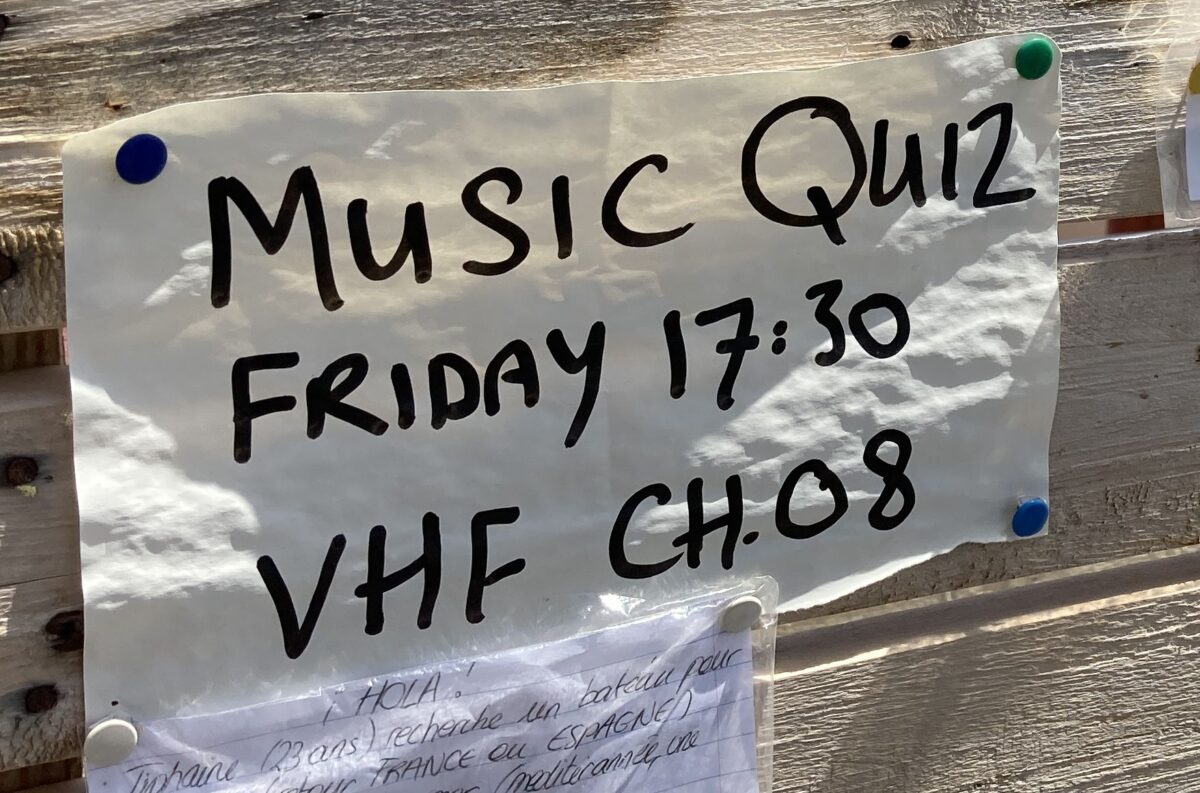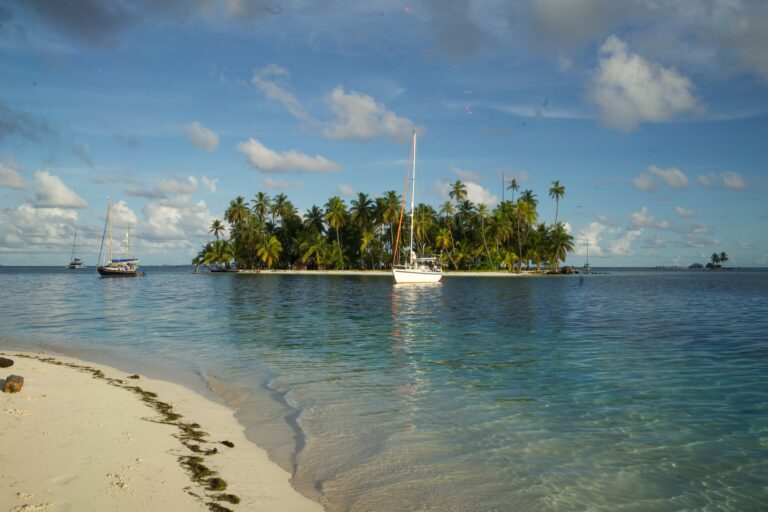Music of the Caribbean
I was cleaning my Spotify the other day. Listening to the old playlists took me back to the music quizzes we had during covid lockdowns, and basically all along the covid year. The world stopped, but in that insanity, we managed to find little pleasures. One of them was the Friday night music quiz held via VHF by John, Les and other cruisers, including us. We loved it so much that even when the lockdown was over, we wouldn’t go to the party until the game was over. I miss it dearly.
Music was definitely crucial to the state of our mental health during pandemic. Not only quizzes. I look back to memories of boat concerts performed by cruisers for cruisers from their boats. Sometimes with the audience tied in their dinghies to the back of the boat, other times, during lockdowns, just played in the darkness of the night. Giorgio, a professional musician who used to play with Philharmonic Orchestra in Turin, was playing on his saxophone. We had Helmut’s one-man rock band with amplifiers, electric guitars, and a microphone! We even had a harpist playing on her instrument in the cockpit of her 41-foot monohull! And imagine, she has two of these on board. Music plays sucha huge role our life that we would probably go sailing on the boat without a working fridge, but never without good speakers.
Sounds from the islands
I started collecting sounds of the street a while ago when we landed on Carriacou back in 2019. The music there was totally different from Martinican. Before, I thought that it would be more or less the same in the whole Caribbean. I couldn’t be more wrong. (I am not talking Friday night beats. However, it would be highly inaccurate not to mention it, as Caribbean night is more often filled with modern than traditional music. For some samples, check out our profile on Spotify). My focus in this article is live music that you can hear on the streets.
I would like to build a library of regional music as we travel around the world. So far, I’ve recorded music during Launch Ceremony in Windward in Carriacou, some on Martinique. I am not yet there with the quality, but I am working on that. But honestly, my biggest challenge is not the device – it is me and my forgetfulness. Most of the time, I keep forgetting the damn recorder, and, obviously, the best things happen when I am not prepared. Rookie mistake – always take your gear with you!
Music from Trinidad
This time I would like to take you to Trinidad, where calypso was born. The first thought that comes to mind when you hear “calypso” is probably steel drums. You picture a group of smiling musicians with shiny steel pans, kinda like a cruise ship commercial inviting you for a true Caribbean experience. And… in fact, geographically speaking, you wouldn’t be very wrong, as steel drums are the national instrument of Trinidad and Tobago. On the historical side, calypso and steel drums come from the same period.
Calypso and steel drums were all closely connected to the Carnival, which was brought to Trinidad by the French in the XVIII century. Carnival was obviously reserved only for white people. Canboulay (fr. canes brulées – burned sugar canes) or Kambule, on the other hand, was slaves feast, parallel to Carnival. In the beginning, it was a harvest festival. Later, after abolition, it turned into a celebration of freedom.
In the beginning, Carnival took the form of fancy house balls, reserved only for high society. Canboulay was street masquerade procession. It was in-your-face mockery** of everything that represented so-called white culture: dances, dresses, social behavior, expressed in the way impossible to handle by the prude society (I bet, even now, most of you would be shocked during the Carnival!). The culmination of the feast was a burning stick fight called calinda, driven by kaiso singer-griot (French creole known as chantuelle or calypsonian), and accompanied by the deep, dramatic beat coming from big wooden drums.
As much as masquerade was just offensive, drumming scared the sh*&^ out of white people. Drums could have been used for entertainment only or for communication, which could have been a call for rebellion, and none of them whities could tell the difference. Later, after abolition, drumming events often ended as a street demonstration against injustice towards the black community. It was seen by the establishment as a danger to the public order. In 1881, Canboulay ended in bloody riots, and that was the final reason to ban drumming. Tradition hasn’t died as hoped. Instruments changed, first to tamboo bamboo and later to steel drums.
For decades steel pans were seen as a lower-class, ghetto hooligan’s instrument associated with the crime world. It gained international recognition thanks to the US troops stationed in Trinidad in the 80s. Now it is the pride of Trinidad, and pannists (musicians) are highly notable citizens. What about calypso? Calypso was born from that traditional Canboulay singing – Kaiso.
** You should probably know that Carnival balls participants dressed up, painted faces, and mocked the slaves for their behavior, customs, and sexuality. Canboulay was basically a payback. However, one group couldn’t stand the offense of the other. Guess which one?
Calypso
Everyone (or at least matured readers 😉 ) can probably recall one or two 80’s pop hits in calypso style, with music videos full of Caribbean cliches and stereotypes. There were also funny appearances in movies like the dinner scene from Beetlejuice. But calypso was so much more than this. It had an important role in society, culture, and musically speaking, a huge impact on reggae, funk, and even hip-hop.
Calypso was sung initially in creole/patois, later mostly in English. And when sung in English, it became an open and bold political voice of criticism of the white government. Politicians seriously discussed songs as they reflected the level of public discontent! Obviously, at some point, it became also a drag for politicians, and they started to censor songs. In response, artists used double-speak and pointed references. We know it so well from totally different parts of the world, from Poland, where communistic censorship pushed artists to never write directly. There was always a second meaning to any good song, book, or film. Same here, under cover of frivolous, goofy lyrics, there was the second bottom.
Calypso was also a reliable source of news and described society accurately. In its social role, with the political and social contexts, you could compare it to hip-hop. Calypso lyrics dealt with sex, scandal, gossip, or took the form of pointed insults. There was even a form of improv battle, based on personal affront and direct challenge called “no mercy” (fr. “sans humanitè”). I bet you can recognize it in present-day music and even in stand-up comedy roasts. Back in the day, same as hip-hop now, Calypso was shocking and outrageous to moralistic parts of society.
For me, music represents the spirit of people. I am drawn by places where you can find music that tells stories and makes you dance. I love Cuban salsa, Jamaican dubs, or reggae and I cannot also go past the street string band in Carriacou or not stop by Big Drums. My latest discovery and love is the sweet music of the Garifuna people from Belize. Caribbean Islands music covers the entire spectrum of emotions. It is aggressive, it is intensive, but it is also sweet, joyful, and optimistic. And… it is all related to Calypso!
I made it easy for you to taste it, below you can find a playlist, or use this link to go directly to our profile on Spotify. You can find some samples of Calypso-related genres like mento, benna, spouge, music from Kuba, Haiti, Jamaica, Antigua and Barbuda, Bahamas, Guadeloupe, Saba, Barbados, Martinique and Carriacou (see below, plus some bonus)
I hope the music will bring some sun to you in the coming winter days (not being mean, just realistic! ;)).
Yo-ho!
Meanwhile off we go to explore the new continent – we are in Colombia
See you soon!
Over and out
White Dog Crew
Traditional Calypso
BONUS for curious
As a bonus, there is also a heavy, heavy, modern Friday night dancehall playlist. From heavy African beats in the southern islands to Flow Latino lovers in the north 🙂







